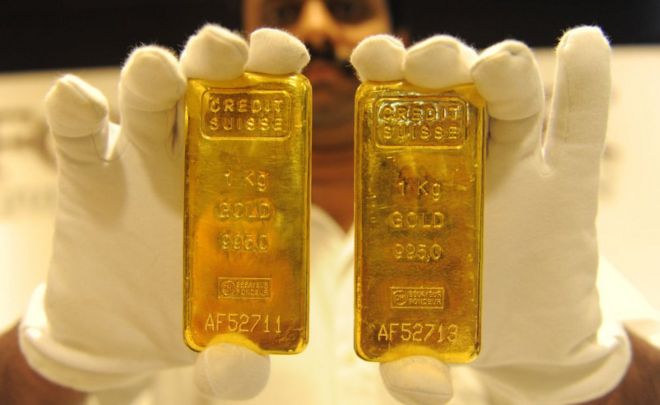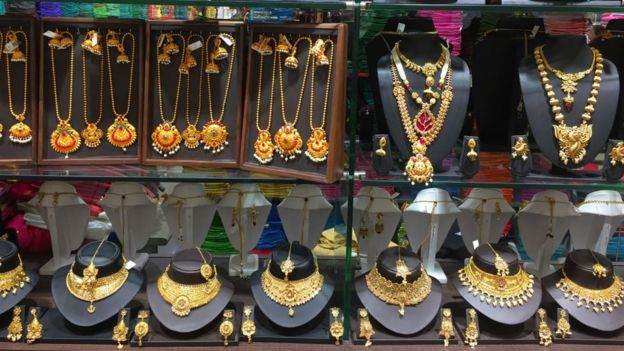India coronavirus: Gold surge as pandemic bothers the nation's economy
To state Indians love gold would be putting it mildly. Over hundreds of years, families - just as sanctuaries - have stored the valuable metal.
As per a World Gold Council gauge from a year ago, all-out gold stores across Indian homes were around 25,000 tons - the biggest in any nation.
 |
| Image Credit: BBC |
One of the outcomes has been a liquidity crunch, which has provoked numerous Indians to go to gold as both venture and guarantee.
Furthermore, they are progressively utilizing it to raise reserves, says ware showcase, master Kunal Shah.
When conventional bank credits are more diligently to stop by, a climb in gold costs has helped fuel the fame of these advances.
Gold costs flooded 28% this year to in excess of 50,000 rupees ($668; £515) per 10 grams. The jump in esteem is because of a few reasons. For one, Western banks are printing money and purchasing gold in the global market as long haul security. Two, financial exchanges the world over are unstable, prodding individuals to put resources into gold, pushing its cost up. Also, with financing costs in a few nations in the negative region, it's unfruitful to keep cash in banks.
The entirety of this has influenced the cost of gold, with specialists saying its worth is set to rise further in the coming months.
 |
| Image Credit: BBC |
She says a gold advance was "the speediest and least expensive choice accessible".
Ms. Parab pawned six bits of gold gems for a gold advance from a neighborhood helpful bank for $3,340. She is paying an enthusiasm of 9.15% every year for a long time. On the off chance that she had selected an individual advance, she would have needed to pay a higher loan fee - simply over 11% - for a similar period.
Ranchers also are seeing gold advances as a lift. Hospital Malviya, a rancher in the western province of Maharashtra, acquired more than $5,000 against gold to begin planting in his homesteads.
"We had a go at taking credit from the banks however they posed such a large number of inquiries and were hesitant, yet the nearby agreeable bank was prepared to help [with a gold loan]," he says.
Gold and individual advances both permit a borrower to utilize the assets any way they wish. Be that as it may, for some, gold advances are the more open of the two - they require fewer reports, gold is regularly effectively accessible with the home as a benefit, and the credits as of now have a higher incentive because of high gold costs. Lower financing costs for gold credits are an additional bit of leeway - presently, loan costs start at simply over 7% and go up to 29%, contingent upon the residency and reimbursement alternatives. In the examination, enthusiasm on close to home credits goes somewhere in the range of 8% and 26% per annum.
Gold credits are scheduled to develop at a lot quicker rate contrasted with individual advances. "We anticipate that they should develop by 10 to 15% this year," says V P Nandakumar, CEO of Manappuram Finance, a non-banking money organization that represents considerable authority in gold loaning.
Gold credits are additionally simpler to get to now as customary business banks have fixed their coffers. A background marked by awful loaning choices has left Indian manages an account with one of the world's most elevated proportions of terrible advances. Furthermore, the pandemic just compounded the situation, leaving banks concerned whether an ever-increasing number of borrowers is probably going to default. The outcome: banks are not loaning as much as they used to.
In 2019, Indian banks endorsed 6% a greater number of credits than the earlier year, as indicated by residential rating office Crisil. This year, they've relied upon to give just 1% more credits than expected - truly, the advance development has been in twofold digits. "Little organizations are coming to us since bank advances will require significant investment. They need transient working capital as the lockdown evaporated all the installment streams," says George Alexander Muthoot, overseeing executive of Muthoot Finance, one of the biggest gold credit organizations in India.
 |
| Image Credit: BBC |
Indeed, even standard banks that have some expertise in gold credits are receiving the rewards - Federal Bank and Indian Bank have seen a 10-overlap ascend sought after for gold advances, essentially in little urban areas and towns.
Furthermore, specialists foresee that gold advances will keep on expanding as costs go up. Prior to the lockdown in March, this cost remained at $38 per gram - at the present time, it's around $44 per gram. So a gold advance currently would bring almost $7 more per gram than it did in March.
"Higher gold costs make both the borrower and loan specialist cheerful," says Somasundaram PR, overseeing executive for India in the World Gold Council.


No comments